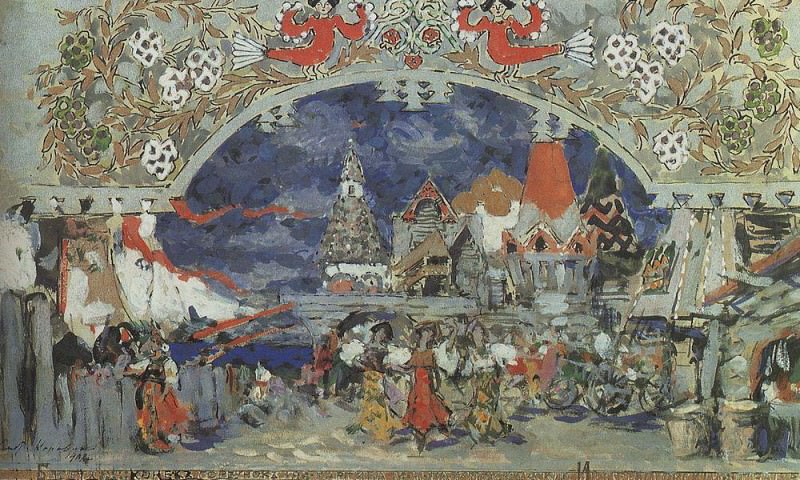Emporium in Grad-capital. 1912 Konstantin Alekseevich Korovin (1861-1939)
Konstantin Alekseevich Korovin – Emporium in Grad-capital. 1912
Edit attribution
Download full size: 1000×600 px (0,2 Mb)
Painter: Konstantin Alekseevich Korovin
Konstantin Korovin was primarily a theatrical artist. To this day, plays in Korovin’s design are still performed and revived in our country. Initially, Konstantin studied at an art school at the architecture department - which apparently helped him a great deal later on in creating scenery and in seeing the perspective of the theatrical stage. Korovin based his work on the principles of Impressionism, but he rarely repeated the techniques typical of that style of painting.
Description of Konstantin Korovin’s painting "Theater
Konstantin Korovin was primarily a theatrical artist. To this day, plays in Korovin’s design are still performed and revived in our country. Initially, Konstantin studied at an art school at the architecture department - which apparently helped him a great deal later on in creating scenery and in seeing the perspective of the theatrical stage.
Korovin based his work on the principles of Impressionism, but he rarely repeated the techniques typical of that style of painting. Korovin’s work is more tangible and concrete, and you can say that he created his own concept of Impressionism. In his canvases the artist was often inspired by Spain, the typical images of this bright southern country at the time; many of the sketches of scenery he created are reminiscent of the Moorish mosaic by their fractional, sunny contrasts.
While working at Mamontov’s private theater, Korovin most often had to decorate fairy tales; it was the fairy tale that most clearly demonstrated his talent as an artist. The fantasy, illusory sketches of the artist often resemble dreams rather than reality; for the theatrical stage his unusual creativity was a great find.
Korovin’s painting The Theater is a complete embodiment of the stage scenery for the play The Little Humpbacked Horse based on Yershov’s fairy tale. The square with its brightly colored tents forms the perspective of the composition. The central characters are dressed in colorful costumes, creating the illusion of an Oriental fairy tale. The terems visible in the background are the quintessence of the holiday; ethnically they combine the picturesque structures of Russian constructions with elements of oriental decor.
Кому понравилось
Пожалуйста, подождите
На эту операцию может потребоваться несколько секунд.
Информация появится в новом окне,
если открытие новых окон не запрещено в настройках вашего браузера.
You need to login
Для работы с коллекциями – пожалуйста, войдите в аккаунт (open in new window).




















You cannot comment Why?
The foreground is dominated by a throng of individuals engaged in various transactions. Their attire suggests a historical setting, with garments rendered in muted tones punctuated by occasional flashes of red. The figures are not individually delineated; instead, they coalesce into a mass of movement and energy, conveying a sense of collective activity rather than individual narratives.
Above the marketplace, an ornate archway serves as a decorative border. This structure is adorned with stylized floral motifs and fantastical creatures – birds rendered in vibrant red – which introduce a layer of symbolic complexity to the scene. The birds’ placement above the market suggests a possible connection between commerce and mythology or folklore. Their stylized nature hints at a deliberate distancing from realism, emphasizing instead an idealized or allegorical representation.
The color palette is characterized by cool blues and greens dominating the sky and background, contrasting with warmer tones of red and brown in the foreground figures and buildings. This contrast creates depth and draws attention to the central activity. The application of paint appears loose and expressive, contributing to a sense of immediacy and vitality.
Subtly, there is an underlying tension between the vibrancy of the marketplace and the formality of the architectural frame. The elaborate archway seems to contain or control the chaotic energy below, suggesting a commentary on the relationship between commerce, tradition, and societal order. The scene evokes a feeling of nostalgia for a bygone era, while simultaneously hinting at the complexities inherent in human interaction and economic activity.